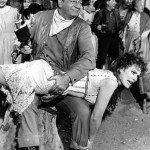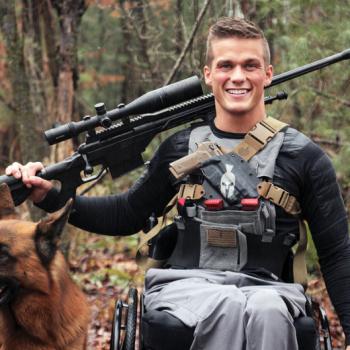This post is part of a series examining the role of the Home School Legal Defense Association (HSLDA) in aiding and abetting child abuse. I have previously looked at HSLDA’s efforts to prevent the reporting of child abuse and their efforts to stonewall child abuse investigations. In this post I will turn to HSLDA’s defense of child abuse.
HSLDA has made a name for itself defending parents’ right to spank their children and spends a good bit of its time and energy monitoring and opposing new child abuse legislation—an odd activity for an organization nominally devoted to protecting the legality of homeschooling. While HSLDA literature continually talks about the importance of defending parents’ use of “reasonable” corporal punishment, the organization has never taken the time to define just what constitutes “reasonable” corporal punishment. Similarly, while HSLDA occasionally makes statements condemning child abuse, I’ve noticed a bit of a pattern—these statements are always followed with the word “however.”
Hiding and Ignoring Child Abuse
In its literature, HSLDA (to my knowledge) never defines “reasonable” corporal punishment, never warns its member families not to abuse their children, and never tells its member families how to handle child abuse they might see in other families in their homeschooling communities. HSLDA’s attorneys are not pioneers in stopping child abuse in homeschooling families; they are pioneers in disabling child abuse protections. Never once does HSLDA touch on how to solve the child abuse problem, perhaps because they don’t see it as a significant problem or perhaps simply because they see it as something “other” people do, not problem some of their own member families might have. While you could argue that HSLDA sees child abuse detection and prevent as important but not as a homeschooling issue, this makes no sense when you consider the amount of time HSLDA spends working to disarm protections for abused children.
Let me give an example of the sort of advice HSLDA gives regarding child abuse and child protective services—In a document titled “The Social Worker at Your Door: 10 Helpful Hints,” HSLDA attorney Christopher Klicka advised parents as follows:
Avoid potential situations that could lead to a child welfare investigation.
b. Do not spank children in public.
c. Do not spank someone else’s child unless they are close Christian friends.
In other words, Klicka is aware that HSLDA member families physically discipline their children in ways many people would consider abusive, and even find concerning enough to actually call Child Protective Services. But instead of addressing where the line between “reasonable” corporal punishment and child abuse is located, he merely advises HSLDA member families to avoid the use of corporal punishment in public. This displays a remarkable lack of care about the very real problem of child abuse, as well as an inability to consider that any of its member families might actually discipline their children in ways that are abusive and should be stopped.
Further, Klicka advises HSLDA member families to restrict their use of corporal punishment on children outside their families to the children of “close Christian friends.” This statement seems to imply that without this suggestion, HSLDA member parents might spank children outside of their families without their parents’ permission and be reported to Child Protective Services for doing so—and also that close Christian friends will de facto be okay with them spanking their children without asking first. After all, why not say “Do not spank someone else’s child unless you have their permission“? Or even, why not say “Do not spank someone else’s child” and leave it there?
There is also the problem of omission—for all of the advice HSLDA gives on how its member families can recognize, avoid, or stonewall child abuse investigation, the organization never takes two seconds to inform its member families how to recognize and avoid child abuse or even how to handle or deal with child abuse in their homeschooling families or communities. One wonders if there are any circumstances at all in which HSLDA would ever recommend that its member families involve CPS.
What Is Child Abuse?
HSLDA’s member manual states that “HSLDA believes that child abuse is a terrible crime and that true abusers should be prosecuted to the fullest extent of the law.” Note the use of the word “true.” The more I read, the more convinced I become that HSLDA does not define child abuse in the same way as most Americans. For example, HSLDA is on record defending foster parents’ rights to use corporal punishment on their foster children, something most Americans would find disturbing. Further, it’s worth noting that the sentence above is one of the many times HSLDA briefly condemns child abuse and then starts the next sentence with the word “However” (see page 3, column 2 of the link).
The only time anyone at HSLDA comes close to discussing what actually counts as child abuse is in discussing a 2008 California law that would have added to the penal code a list of actions for jurors to consider when determining if a form of discipline is “unjustifiable.” In a Washington Times op ed, HSLDA president J. Michael Smith explained that HSLDA had no problem with most of the items on the list—stating that these things were indeed child abuse—and that the organization only opposed the law because it took exemption to the listing of hitting children with objects. Here are his words:
This bill amends Penal Code section 273(a), which makes it a crime to cause unjustifiable pain, harm or injury to any minor child. If the bill passes, spanking with an object such as a stick, rod or switch would be lumped in with throwing, kicking, burning, or cutting a child.
Striking a child with a fist. Striking a child under 3 years of age on the face or head. Vigorously shaking of a child under 3 years of age. Interfering with a child’s breathing. Brandishing a deadly weapon upon a child. These are all factors that a jury could use to conclude that a defendant in a criminal case has inflicted unjustifiable physical pain or mental suffering.
What the bill would do is to equate discipline administered via an implement with the above conduct, which obviously is abusive behavior toward a child.
Now of course, this is no actual laying out of a comprehensive definition of child abuse—Smith merely goes down the items listed in the bill. Further, I’m less than willing to trust what HSLDA spokespeople say in public forums given that Farris claimed in an article for popular readership that requiring social workers to have either parental consent or a warrant to enter a home was be no biggie because the vast, vast majority of people voluntarily let social workers in, even as the organization advises its members to never never never let a social worker into their homes without a warrant, ever. Still, it does appear that HSLDA does view some actions—such as violently shaking a small child or striking a child with a fist—to be child abuse. Whether it warns its member families against these actions or ever takes the time to define “reasonable” corporal punishment, however, is another story.
For the record, I am personally against any form of physical punishment of children, and am raising my two young children without laying a hand to them. In contrast, many conservative Christians, including those who founded and run HSLDA, believe strongly that the Bible demands that parents use corporal punishment on their children (they take “spare the rod, spoil the child” stuff literally). Most Americans fall somewhere in between these two positions: they believe that some form of corporal punishment can be employed without crossing the line into child abuse, but also that spanking should consist merely of swatting a child’s buttocks with an open hand and that this form of punishment is usually unnecessary. The question I want to ask here is not whether or not corporal punishment is acceptable but rather where HSLDA draws the line between “reasonable corporal punishment” on the one hand and child abuse on the other. The reason I titled this post as I have is that HSLDA appears to define child abuse differently from the average American.
Given that HSLDA never defines “reasonable corporal punishment” or gives any sort of comprehensive definition of child abuse, I want to take a look at the organization’s positions regarding three different proposed state child abuse statute changes over the past five years. Their positions and advocacy on these bills represent a small fraction of HSLDA’s monitoring of child abuse statute changes across the nation—something the organization watches very closely and doesn’t hesitate to use its e-alert system to mobilize its members in lobbying—but should give us a sample of how HSLDA talks about and defines “reasonable” corporal punishment and what it does or does not include as child abuse.
HSLDA in California: Don’t Restrict Disciplining with Objects!
We’ll start with the HSLDA’s opposition to the proposed 2008 revision of California’s child abuse statute referenced above. At the time, the state’s statute banned causing children “unjustifiable physical pain or mental suffering.” The new bill kept this same language but added the following:
In a prosecution under this Section in determining whether or not a defendant willfully caused any child to suffer, or inflicted unjustifiable physical pain, or mental suffering, a jury may consider any of the following:
a) The use of an implement, including, but not limited to, a stick, a rod, a switch, an electrical cord, an extension cord, a belt, a broom, or a shoe.
b) Throwing, kicking, burning, or cutting a child.
c) Striking a child with a closed fist.
d) Striking a child under the age of three on the face or head.
e) Vigorous shaking of a child under the age of three.
f) Interference with a child’s breathing.
g) Brandishing a deadly weapon upon a child. However, the above conduct is not sufficient by itself to prove guilt, and its weight and significance, if any, is for the jury to decide.
HSLDA explained its opposition to this change as follows:
The instructions to a jury which are mandated by the current version of A.B. 2943 would state that a jury may consider that physical pain or mental suffering inflicted upon a child is unjustifiable if it is caused by any of the seven kinds of actions…. The first of the seven actions listed is “the use of an implement, including, but not limited to, a stick, a rod, a switch, an electrical cord, an extension cord, a belt, a broom, or a shoe.” This first action includes the act of spanking with an object other than using one’s hand. Because these items would be listed in the Penal Code, the police and district attorney would likely consider all spanking with an implement grounds for bringing charges against the parents. Then a court trial would determine if the parents are guilty of criminal child abuse. Parents would have the difficult task of proving that the spanking was justifiable to the satisfaction of the court in order to avoid being sent to jail for up to one year or receiving other penalties. The case also could be referred to Child Protective Services (CPS) and Juvenile Court, which could result in the possible temporary or permanent loss of custody of their children.
In other words, HSLDA opposed this bill because it listed beating child with a stick, rod, or electrical cord as a factor the jury should take into account when determining whether or not the actions of a parent accused of child abuse were justifiable. Indeed, HSLDA has a pattern of opposing laws that would ban hitting children with objects, even without banning spanking itself. We can safely conclude that HSLDA does not consider hitting children with objects to be child abuse.
But there’s another reason I started with this example, and that’s because of the way HSLDA uses this sort of case in an attempt to induce fear in its member families, distorting the facts and engaging in hyperbole in order to do so. I mean just look at the title of HSLDA president J. Michael Smith’s Washington Times op ed’s title: “California May Ban Spanking.” This bill absolutely would not have banned spanking, and it would not have even banned the use of a paddle—it would instead have merely stated that when determining whether the pain a parent inflicted on a child was unjustifiable, the jury should consider whether an implement should be used. But none of that mattered to HSLDA, which saw a chance to hold the specter of a complete ban on spanking over the head of its member followers.
HSLDA in Mississippi: “Reasonable Discipline” Exemption Not Enough
Next we move to the Deep South. In January of 2012 HSLDA opposed a change to Mississippi’s child abuse statute. Let’s start by looking at the original text of this section of Mississippi’s code:
(2) (a) Any person who shall intentionally (i) burn any child, (ii) torture any child or, (iii) except in self-defense or in order to prevent bodily harm to a third party, whip, strike or otherwise abuse or mutilate any child in such a manner as to cause serious bodily harm, shall be guilty of felonious abuse of a child and, upon conviction, shall be sentenced to imprisonment in the custody of the Department of Corrections for life or such lesser term of imprisonment as the court may determine, but not less than ten (10) years. For any second or subsequent conviction under this subsection, the person shall be sentenced to imprisonment for life.
In other words, if you burn or torture a child, or whip or strike a child so as to cause that child serious bodily harm, you can be prosecuted for child abuse. Brice Wiggins, a Republican state senator, became convinced that the statute did not do enough to penalize child abuse, and introduced a bill to entirely rewrite this section of the code. So let’s look at how his 2012 bill would have amended the code:
(2) (a) (i) A person shall be guilty of felonious abuse of a child if the person intentionally and in a manner causing bodily harm shall:
1. Burn any child;
2. Torture any child;
3. Strangle or choke any child;
4. Disfigure, scar or mutilate any child; or
5. Whip, strike or otherwise abuse any child except as a result of reasonable discipline, in self-defense or in order to prevent bodily harm to a third party.
(ii) A person who is convicted of felonious abuse of a child shall be sentenced to imprisonment in the custody of the Department of Corrections for life or such lesser term of imprisonment as the court may determine, but not less than ten (10) years. For any second or subsequent conviction under this subsection, the person shall be sentenced to imprisonment for life.
(iii) Reasonable discipline shall be a defense to any criminal charge brought under this subsection.
The new statute would prohibit striking or whipping a child so as to cause “bodily harm,” rather than “serious bodily harm” as in the previous statute, but would also insert an exception to this prohibition for “reasonable discipline.” Or to put it another way, while parents before could legally strike or whip their children so as to cause bodily harm whether or not it was done as part of “reasonable discipline” (just so long as they didn’t cause serious bodily harm), under the new revisions parents could only strike or whip their children so as to cause bodily harm as part of “reasonable discipline.”
HSLDA opposed this revision, explaining as follows:
Summary: This bill would make it a felony to “whip, strike or otherwise abuse any child,” thereby causing bodily harm to the child. The maximum penalty would be life in prison. “Reasonable discipline” would be an exception to this offense, but what is reasonable would be left up to judges to decide.
HSLDA’s Position: This bill has the potential to send a parent to prison for life for spanking a child. This bill should be opposed.
First note the fear mongering: “This bill has the potential to send a parent to prison for life for spanking a child.” This makes absolutely no sense—listing a “reasonable discipline” exemption to a law that banned striking a child so as to cause bodily harm clearly indicates that striking your child so as to cause harm can be reasonable discipline. Else why the exemption? In other words, contrary to what HSLDA told its member families, the bill would actually have codified spanking as “reasonable discipline.” HSLDA’s actions here were nothing short of lying and conniving fear mongering—and HSLDA did kick up a good bit of fear as conservative media outlets picked up the story, quoting HSLDA spokespeople and running alarmed headlines like “Miss. Bill Could Mean Life Imprisonment for Parents.” Given that HSLDA makes its money off of selling legal insurance, scare mongering is where it’s at its best. In fact, some have suggested that the organization may intentionally beef up the legal alerts it sends out right around the time it does its membership drive.
HSLDA claimed to oppose the bill because “reasonable discipline” was not defined and would be left up to judges to interpret. What this indicates to me is that HSLDA is aware that its member families define “reasonable discipline” appreciably differently from most Americans—or at least differently from Mississippi judges. What HSLDA wanted was for the law to allow its members to strike or whip their children so as to cause bodily harm without having to prove to judges that their actions constituted “reasonable discipline,” or at the very least an expansive and detailed definition of what constituted “reasonable discipline.” And HSLDA got its way when a new version of the bill was introduced early this year—a bill HSLDA did not oppose. Here is how this bill amended the statute to read:
(2) Any person shall be guilty of felonious child abuse in the following circumstances:
(a) Whether bodily harm results or not, if the person shall intentionally, knowingly or recklessly:
(i) Burn any child;
(ii) Physically torture any child;
(iii) Strangle, choke, smother, or in any way interfere with any child’s breathing;
(iv) Poison a child;
(v) Starve a child of nourishments needed to sustain life or growth;
(vi) Use any type of deadly weapon upon any child;
(b) If some bodily harm to any child actually occurs, and if the person shall intentionally, knowingly, or recklessly:
(i) Throw, kick, bite, or cut any child;
(ii) Strike a child under the age of fourteen (14) about the face or head with a closed fist;
(iii) Strike a child under the age of five (5) in the face or head;
(iv) Kick, bite, cut or strike a child’s genitals; circumcision of a male child is not a violation under this subpagragraph;
(c) If serious bodily harm to any child actually occurs, and if the person shall intentionally, knowingly or recklessly:
(i) Strike any child on the face or head;
(ii) Disfigure or scar any child;
(iii) Whip, strike, or otherwise abuse any child;
The new bill banned striking or whipping a child so as to cause them “serious bodily harm” but made a broad allowance for causing a child bodily harm, excepting only bodily harm caused by throwing, kicking, biting, or cutting, striking a child under 14 in the face or head with a closed fist, striking a child under 5 in the face or head, and kicking, biting, cutting, or striking a child’s genitals. Or to put it another way, under the new bill it would be legal to cause your child bodily harm without having to prove that doing so constituted “reasonable discipline,” so long as that bodily harm was not caused by things like biting, kicking, punching in the face, or trauma to the genitals. With this change, HSLDA no longer saw this law as a threat to its members’ “right” to discipline their children using “reasonable” corporal punishment.
Just how did the law define “bodily harm” and “serious bodily harm”?
(e) For the purposes of this subsection (2), “bodily harm” means any bodily injury to a child that includes, but is not limited to, bruising, bleeding, lacerations, soft tissue swelling, and external or internal swelling of any body organ.
(f) For the purposes of this subsection (2), “serious bodily harm” means any serious bodily injury to a child and includes, but is not limited to, the fracture of a bone, permanent disfigurement, permanent scarring, or any internal bleeding or internal trauma to any organ, any brain damage, any injury to the eye or ear of a child or other vital organ, and impairment of any bodily function.
With these definitions, then, the new bill left it legal for parents to beat their children so as to cause “bruising, bleeding, lacerations, soft tissue swelling, and external or internal swelling of any body organ” without even having to pass any sort of “reasonable discipline” standard. The reason HSLDA had opposed the 2012 version of the bill—but not this one—was that the former version only allowed parents to strike or whip their children so as to cause bodily harm if it was done as part of “reasonable discipline,” a standard they did not want their member families burdened to meet. HSLDA was successful in opposing the original bill and this travesty of a child abuse statute is the result.
HSLDA in Florida: Significant Bruising and Welts are A-Okay
Finally we turn to Florida. In 2010, HSLDA sent out a legislative alert about Florida’s Senate Bill 1360, urging its members to oppose the measure. Here is the text:
Summary: Includes inappropriate or excessively harsh corporal discipline in the definition of “criminal conduct” for purposes of protective investigations. Prohibits parents, legal custodians, or caregivers from inflicting such corporal discipline. Provides penalties and applicability. Includes offenses involving inappropriate or excessively harsh corporal discipline within the offense severity ranking chart of the Criminal Punishment Code, etc.
HSLDA’s Position: Oppose.
This one had me scratching my head. Why would HSLDA oppose a bill outlawing “excessively harsh corporal discipline”? Isn’t their typical line that they defend “reasonable” corporal punishment (which they never define)? Doesn’t that make them de facto against excessively harsh corporal punishment? Just what “inappropriate or excessively harsh” corporal punishment did SB 130 add to the criminal code? Let’s have a look at the text of the actual bill. The bill begins as follows:
Section 1. Paragraph (b) of subsection (2) of section 39.301, Florida Statutes, is amended to read:
(2) (b) As used in this subsection, the term “criminal conduct” means:
1. A child is known or suspected to be the victim of child abuse, as defined in s. 827.03; or of neglect of a child, as defined in s. 827.03; or of inappropriate or excessively harsh corporal discipline, as defined in s. 827.032.
In other words, the statute originally listed “child abuse” and “neglect” as “criminal conduct” and this bill would have amended it to also include “excessively harsh corporal discipline” alongside “child abuse” and “neglect.” How does the bill define “excessively harsh corporal discipline”?
Section 2. Section 827.032, Florida Statutes, is created to read:
827.032 Inappropriate or excessively harsh corporal discipline; penalties.—
(1) As used in this section, the term “inappropriate or excessively harsh corporal discipline” means an act of discipline that results or could reasonably be expected to result in any of the following or other similar injuries:
(a) Sprains, dislocations, or cartilage damage.
(b) Bone or skull fractures.
(c) Brain or spinal cord damage.
(d) Intracranial hemorrhage or injury to other internal organs.
(e) Asphyxiation, suffocation, or drowning.
(f) Injury resulting from the use of a deadly weapon.
(g) Burns or scalding.
(h) Cuts, lacerations, punctures, or bites.
(i) Disfigurement.
(j) Loss or impairment of a body part or function.
(k) Significant bruises or welts.
(l) Mental injury, as defined in s. 39.01.
The bill defines excessively harsh corporal discipline, then, as that which results in bone fractures, suffocation, burns, cuts, disfigurements significant bruises and welts, etc. HSLDA did not explain its opposition to this bill. The only thing that makes any sense to me is that HSLDA opposed it because it listed “significant bruises or welts” as “excessive corporal discipline.” HSLDA’s concern must have been that banning discipline that resulted in significant bruises and welts infringed on parents’ rights to use “reasonable corporal punishment” on their children. It seems, then, that disciplinary actions that leave “significant bruises or welts” fit within HSLDA’s definition of “reasonable corporal punishment.”
Concluding Thoughts
Given the lack of any word from HSLDA on what constitutes “reasonable” corporal punishment, we have to piece together HSLDA’s definition of that term by examining its positions on bills revising state child abuse statutes, which HSLDA monitors closely. What we find when we do this is that HSLDA opposes laws that would ban hitting children with physical objects, striking or whipping children so as to cause bodily harm in a manner that judges would not consider “reasonable discipline,” and disciplining children in a manner that leaves significant bruises or welts. It would seem that all of these things fit within HSLDA’s definition of “reasonable corporal punishment.” And, beyond that, it appears that HSLDA is aware that its members use corporal punishment that many if not most Americans would consider child abuse.
If HSLDA’s view of child abuse reporting and child abuse investigations as bad things that need to be cut down on or obstructed was disturbing, HSLDA’s actions and views regarding child abuse itself are more so.
HSLDA seems to see child abuse as something that happens “out there” and to “other people,” not something that happens within its own member families and needs to be treated seriously. Further, HSLDA appears to view child abuse as something that always exists in extremes, in children with broken bones and starved bodies—and if its member families aren’t engaging in those sorts of activities, then they can’t be abusers, right? But what the organization refuses to admit is that it is a continuum, and that much of what it considers “reasonable” corporal punishment is considered by most Americans to be child abuse. And through all of this, HSLDA makes no attempt to draw a line between reasonable corporal punishment and child abuse or advise its member families on anything other than how to hide abuse—and by not speaking, they are complicit.
Finally, HSLDA seems oblivious to the fact that its opposition to bills criminalizing child abuse might actually aid and abet abusers to continue their abuse. After all, thanks to HSLDA it is now perfectly legal in Mississippi for a parent to whip a child bloody, or beat a child with a rod until he is covered with welts, all without even having to justify this activity as “reasonable discipline.” This sort of thing affects real people, real children, real lives.














